Any similarities between Ancient Egypt and Somali culture should be recorded hereHangool is a Somali nomadic elder's stick
Exactly replica of Egyptian deity stick as held by former pharoah Imhotep
Amin Amir made that number 8 because Faysal carries it all the time
Ancient Egyptian and Somali cultural similarities.
Moderators: Moderators, Junior Moderators
Forum rules
This General Forum is for general discussions from daily chitchat to more serious discussions among Somalinet Forums members. Please do not use it as your Personal Message center (PM). If you want to contact a particular person or a group of people, please use the PM feature. If you want to contact the moderators, pls PM them. If you insist leaving a public message for the mods or other members, it will be deleted.
This General Forum is for general discussions from daily chitchat to more serious discussions among Somalinet Forums members. Please do not use it as your Personal Message center (PM). If you want to contact a particular person or a group of people, please use the PM feature. If you want to contact the moderators, pls PM them. If you insist leaving a public message for the mods or other members, it will be deleted.
-
The`Republic
- SomaliNet Heavyweight

- Posts: 4133
- Joined: Tue Aug 14, 2007 6:28 pm
Ancient Egyptian and Somali cultural similarities.
Spin off from Amin Amir's new caricature topic
- KingMJ
- SomaliNet Heavyweight

- Posts: 4191
- Joined: Sun Dec 05, 2010 1:04 pm
- Location: Back frm the Dead
Re: Ancient Egyptian and Somali cultural similarities.
Good thread 
I remember someone telling me about a pastime with sticks that somalis historically did: Stick fighting - Istunka

Which is also what the Ancient Egyptians did : http://ejmas.com/jcs/2007jcs/jcsart_riddle_0807.html
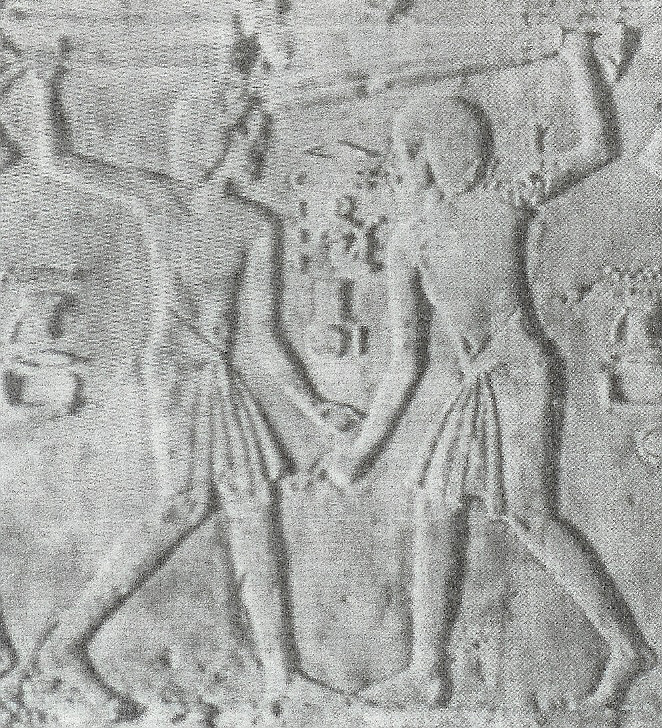
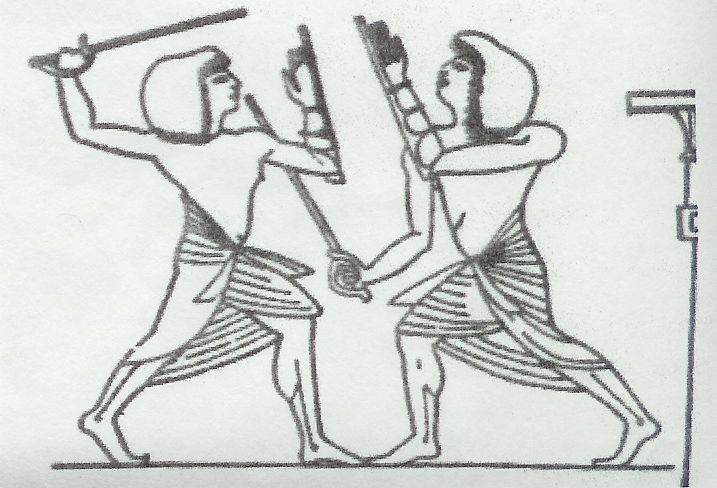
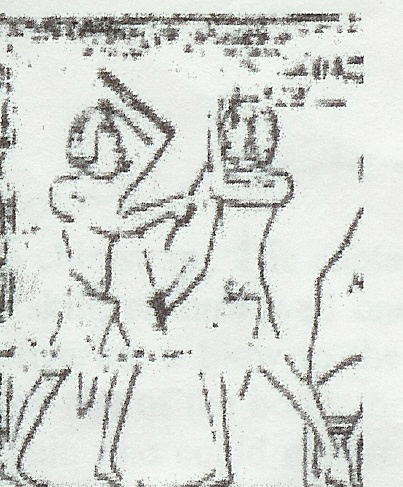
I remember someone telling me about a pastime with sticks that somalis historically did: Stick fighting - Istunka

Which is also what the Ancient Egyptians did : http://ejmas.com/jcs/2007jcs/jcsart_riddle_0807.html



- Cirwaaq
- SomaliNet Super

- Posts: 6472
- Joined: Wed Mar 24, 2010 2:37 pm
- Location: Event Horizon periphery... HIILumination
Re: Ancient Egyptian and Somali cultural similarities.
Egyptians and Somalis both used this head rest and for some reason prefered it over a soft cotton pillow.


- ZubeirAwal
- SomaliNet Super

- Posts: 15174
- Joined: Sat Mar 19, 2011 1:05 pm
- Location: No one feels safe from hypocrisy except the hypocrite.
Re: Ancient Egyptian and Somali cultural similarities.
I made a thread awhile ago on ancient egyptians doing dhaanto  , seriously tho, no excavations have been done in the northern regions inhabited by somalis, waqooyi galbeed prolly has loads of artifacts and pottery from the ancient egyptian times. Funny thing is, everytime i watch a documentary about Ancient egypt and the land of punt, they go as close as yemen and eritrea but never mention somalis, Somalis i believe have the most biggest things under their soil waiting to be excavated, idk about u but my uncle's big brother said during the civil war in hargeisa and when hargeisa was deserted, a few men came to bury the dead, they found a huge old collection of tablets while they were diggin the 6 foot grave, the sheikhs took it out, and they decided it is better if it remained underground.
, seriously tho, no excavations have been done in the northern regions inhabited by somalis, waqooyi galbeed prolly has loads of artifacts and pottery from the ancient egyptian times. Funny thing is, everytime i watch a documentary about Ancient egypt and the land of punt, they go as close as yemen and eritrea but never mention somalis, Somalis i believe have the most biggest things under their soil waiting to be excavated, idk about u but my uncle's big brother said during the civil war in hargeisa and when hargeisa was deserted, a few men came to bury the dead, they found a huge old collection of tablets while they were diggin the 6 foot grave, the sheikhs took it out, and they decided it is better if it remained underground.
- Cirwaaq
- SomaliNet Super

- Posts: 6472
- Joined: Wed Mar 24, 2010 2:37 pm
- Location: Event Horizon periphery... HIILumination
Re: Ancient Egyptian and Somali cultural similarities.
Akhen-Aton was said to have a condition that is common among somalis. Retarded puperty(immaturity), lack of facial hair, baby fat into old age, femanine thighs and high pitch voice and primarily elongated facial structure, long fingers and feet. Florisch’s syndrome

There is one member on this forum that posted their pic that was identical in facial proportions.

There is one member on this forum that posted their pic that was identical in facial proportions.
Re: Ancient Egyptian and Somali cultural similarities.
The headrest, cane, dancing, etc aren't unique to Somalis. Other Africans' claims to similarity or even kinship to ancient Egyptians is as or even more valid than Somalis' claims.






-
The`Republic
- SomaliNet Heavyweight

- Posts: 4133
- Joined: Tue Aug 14, 2007 6:28 pm
Re: Ancient Egyptian and Somali cultural similarities.
Arabman-
In the Egyptian hieroglyphics the deity stick is spelled in letters h-n-g-l and Somali it is called hangool. In Egyptian language the pillow was called barshin and in Somali called barkin. In Egytian language their sun god called Rah and in Somali the sun is called Qor-rah (the neck of rah). In Egyptian their bird like main god was called Horus and in Somali the stork is called Huur. Etc etc etc. Thanks.
Keep the thread going guys...so far we have the hangool stick, the barshin/barkin pillow, the istun/stick fighting. We already know of the linguistic, geographic, and the recent genetic evidence that has been uncovered but cultural relics I find interesting:
Women's dress
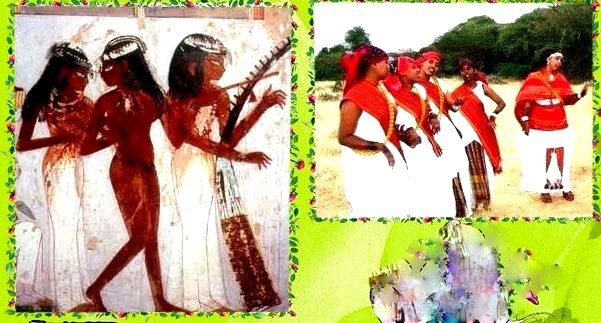

Egyptians playing a dance in a mausoleum looks similar to the oldest Somali dance the Dhaanto
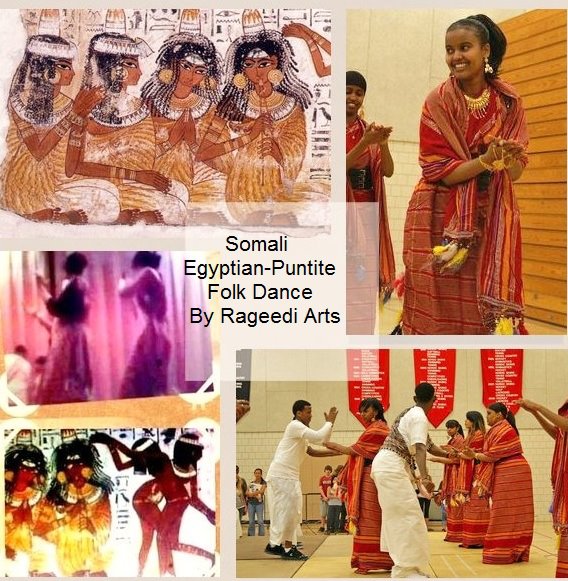
In the Egyptian hieroglyphics the deity stick is spelled in letters h-n-g-l and Somali it is called hangool. In Egyptian language the pillow was called barshin and in Somali called barkin. In Egytian language their sun god called Rah and in Somali the sun is called Qor-rah (the neck of rah). In Egyptian their bird like main god was called Horus and in Somali the stork is called Huur. Etc etc etc. Thanks.
Keep the thread going guys...so far we have the hangool stick, the barshin/barkin pillow, the istun/stick fighting. We already know of the linguistic, geographic, and the recent genetic evidence that has been uncovered but cultural relics I find interesting:
Women's dress


Egyptians playing a dance in a mausoleum looks similar to the oldest Somali dance the Dhaanto

-
grandpakhalif
- SomaliNet Super

- Posts: 30687
- Joined: Tue Sep 01, 2009 10:32 am
- Location: Darul Kufr
- Contact:
Re: Ancient Egyptian and Somali cultural similarities.
This thread sickens me to the bone wallahi, why on Earth in god's name would anybody want to associate themselves with idol worshipping, disobedient, cursed and a hell bound people wallahi. They use to worship their Pharaohs and other mythical idols, and were cursed by God and destroyed in the red nile. They ceased to exist no more after that debacle.
It baffles me how any muslim can gain pride from associating from such a cursed people.
It baffles me how any muslim can gain pride from associating from such a cursed people.
Wallahi if it was up to me I would destroy this idols, pyramids in Egypt.Narrated Abu Huraira: The Prophet said, "Do not set out on a journey except for three mosques i.e. Al-Masjid-AI-Haram, the Mosque of Allah's Apostle , and the Mosque of Al-Aqsa, (Mosque of Jerusalem)."
Re: Ancient Egyptian and Somali cultural similarities.
Ancient Egyptian is Afro-Asiatic, so some similarity to the Somali (as well as Arabic, Amharic, etc) is to be expected. Except for the few similarities you mentioned, I couldn't find much similarity in the vocabulary, like in this link:The`Republic wrote:Arabman-
In the Egyptian hieroglyphics the deity stick is spelled in letters h-n-g-l and Somali it is called hangool. In Egyptian language the pillow was called barshin and in Somali called barkin. In Egytian language their sun god called Rah and in Somali the sun is called Qor-rah (the neck of rah). In Egyptian their bird like main god was called Horus and in Somali the stork is called Huur. Etc etc etc. Thanks.
http://www.donf.com/egypt/medu/vocab1.htm
The hangool you claimed is the exact copy isn't so.

The Egyptian one in the picture is a scepter, made of metal:
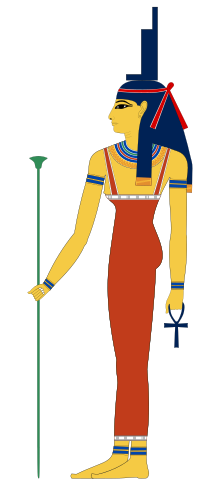

The scepter and hangool have totally different functions.
The dance similarities you claimed are generic dances found in many East, North and West African communities.

As for the fashion similarities, other communities in many parts of Africa have similar fashion. A simple search of Google Image would give you ample examples.
Good point.grandpakhalif wrote:This thread sickens me to the bone wallahi, why on Earth in god's name would anybody want to associate themselves with idol worshipping, disobedient, cursed and a hell bound people wallahi. They use to worship their Pharaohs and other mythical idols, and were cursed by God and destroyed in the red nile. They ceased to exist no more after that debacle.
It baffles me how any muslim can gain pride from associating from such a cursed people.
- Cirwaaq
- SomaliNet Super

- Posts: 6472
- Joined: Wed Mar 24, 2010 2:37 pm
- Location: Event Horizon periphery... HIILumination
Re: Ancient Egyptian and Somali cultural similarities.
There is a mechanical function of this tool which supports it's origins in a place where mankind had to work with thorn bush tree.

The thorn bush is unique to the semi deserts of the horn of africa.

If a sheeb or a goal was to wonder off into a field covered with one of this thornbush tress it is pretty difficult to avoid having your entire skin peeled off.
The head of the hangool acts as a catchment in time of pulling at these bushes.
The base of the hangol acts as a levered tool to push away thorny branches.
There is no function that is mechanical for this tool in a desert. Both the thornbush and the design of the hangool are unique to the horn of africa. The colonisation of the horn of africa may have began on the coast and a battle thus began inland against the thornbush that covered the surface of the horn of africa. This made possible by the Hangool...
It was an inhospitable place with canctus, snakes and many species of plant life that are not easy to handle with bare hands...

The thorn bush is unique to the semi deserts of the horn of africa.

If a sheeb or a goal was to wonder off into a field covered with one of this thornbush tress it is pretty difficult to avoid having your entire skin peeled off.
The head of the hangool acts as a catchment in time of pulling at these bushes.
The base of the hangol acts as a levered tool to push away thorny branches.
There is no function that is mechanical for this tool in a desert. Both the thornbush and the design of the hangool are unique to the horn of africa. The colonisation of the horn of africa may have began on the coast and a battle thus began inland against the thornbush that covered the surface of the horn of africa. This made possible by the Hangool...
It was an inhospitable place with canctus, snakes and many species of plant life that are not easy to handle with bare hands...
-
The`Republic
- SomaliNet Heavyweight

- Posts: 4133
- Joined: Tue Aug 14, 2007 6:28 pm
Re: Ancient Egyptian and Somali cultural similarities.
Even though they are exactly the same and replica of each other, lol @ one is made of metal another wood. How obtuse; however not surprised. Totally expected from the perennially disagreeable Arabman. Before you go on another frowning moment, try to comprehend the point of the topic. I inquired about Ancient Egyptian and Somali cultural similarities. There is not a single moment where I said such similarities are limited to Somalis therefore your entire participation thus far is facetious. It is quite irrelevant.
Grandpa, why politicize the topic? We seek to find cultural similarities not parallel in socio-religious values.
I hope to see what other similarities others find.
Grandpa, why politicize the topic? We seek to find cultural similarities not parallel in socio-religious values.
I hope to see what other similarities others find.
Re: Ancient Egyptian and Somali cultural similarities.
Somalis call Egypt MASAR which means headscarf referring to the fact that in ancient Egypt all the people wore some kind of headscarves. Thus, Somalis called Egypt the land of headscarves. The name was also adopted by Arabs who also use MASAR for Egypt. 
- Cirwaaq
- SomaliNet Super

- Posts: 6472
- Joined: Wed Mar 24, 2010 2:37 pm
- Location: Event Horizon periphery... HIILumination
Re: Ancient Egyptian and Somali cultural similarities.
Lol Trust somalis to invent the term "Turban head".2ndtoNone wrote:Somalis call Egypt MASAR which means headscarf referring to the fact that in ancient Egypt all the people wore some kind of headscarves. Thus, Somalis called Egypt the land of headscarves. The name was also adopted by Arabs who also use MASAR for Egypt.
This Nigerain girl had a baby and brought her child into work. I was shocked to notice the baby had Somali hair and she explained that most of her people are born with that hair but it will soon fall off and the coarse adult hair will take it's place
My theory is: The mutation visible in the Somalis coupled with Florisch’s syndrome (Retarded puperty) May also explain our inablity to share anything.
-
LobsterUnit
- SomaliNet Super

- Posts: 10442
- Joined: Mon Nov 02, 2009 2:19 pm
- Location: singapore
Re: Ancient Egyptian and Somali cultural similarities.
ancient egyptians considered catha edulis to be a divine leave. catha edulis= khat 
-
- Similar Topics
- Replies
- Views
- Last post
-
- 26 Replies
- 2934 Views
-
Last post by Grant
-
- 1 Replies
- 8622 Views
-
Last post by theologain
-
- 2 Replies
- 11329 Views
-
Last post by Caesar
-
- 7 Replies
- 1605 Views
-
Last post by KnowThySelf23
-
- 5 Replies
- 2380 Views
-
Last post by Icey
-
- 0 Replies
- 1145 Views
-
Last post by The Magnificent
-
- 14 Replies
- 3421 Views
-
Last post by YummyMummy
-
- 5 Replies
- 1278 Views
-
Last post by zackabdul
-
- 19 Replies
- 4305 Views
-
Last post by original dervish
-
- 34 Replies
- 26109 Views
-
Last post by BlackVelvet

